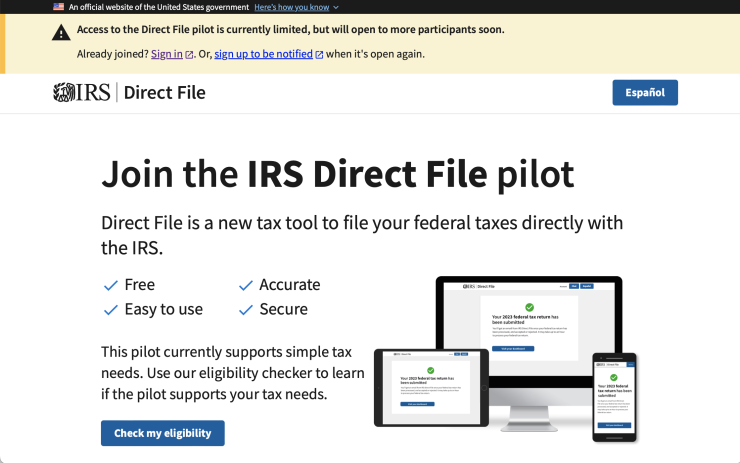Accounting
IRS adds AGI import to Direct File
Published
1 year agoon

The Internal Revenue Service has added a new feature to the Direct File free tax filing program that will import a taxpayer’s adjusted gross income from the previous year, according to the Treasury Department as a new government report finds the program could cost the IRS considerably more than the estimated $64 million to $249 million per year to maintain.
The IRS has been pilot testing the
“An important update has been made to IRS Direct File to better serve taxpayers and minimize user error,” said a Treasury official in an email Tuesday. “When taxpayers finish their returns and it’s time to file, they must enter last year’s AGI or temporary PIN as the final step before submitting. With online filing options taxpayers have previously used, this information is imported from past years. An upgrade made today to Direct File will pull last year’s AGI from the information the IRS already has about you to minimize taxpayer error. In the opening weeks of Direct File being widely available, this was the most common mistake taxpayers would make because the information was not readily available to them because Direct File is a new tool. This upgrade is an example of how Direct File is being updated with taxpayers at the forefront.”
The Treasury said taxpayers are only able to access information from their own IRS account, which is protected via National Institute of Standards and Technology-compliant identity verification, and they cannot retrieve information for anyone else.
“Direct File was built with and for taxpayers and has been continuously improved based on their feedback and experience,” said Bridget Roberts, Direct File lead at the IRS, in a statement Tuesday. “This important update will allow Direct File users to take advantage of information the IRS already has to simplify the filing process even further.”
Separately on Tuesday, the Government Accountability Office released a
The program is largely funded by the Inflation Reduction Act of 2022, which allocated $80 billion over 10 years to the IRS to improve taxpayer service, technology and enforcement, although Congress later rescinded about $20 billion of that amount as part of a deal to avert a default on the debt limit. The Inflation Reduction Act appropriated funds for the IRS to study the cost of developing and running a free Direct File tax return system and included a provision for the GAO to oversee the distribution and use of such funds.
A group of tax software companies have banded together to oppose expansion of the Direct File program and issued a statement in response to the GAO report.
“The report released today by GAO confirms the IRS Direct File program is an unnecessary and expensive solution in search of a problem,” said David Ransom, counsel for the American Coalition for Taxpayer Rights. “As the report demonstrates, the agency’s cost estimates — already in the hundreds of millions — failed to include startup costs, including the technology needed to launch the tool. As the tax filing season nears its end, we’re seeing just how little the appetite is for government-completed tax returns. Roughly 50,000 of the 19 million eligible Americans — far less than one percent — have used Direct File. In contrast, the tax industry provided nearly 30 million free returns last year. The millions of dollars spent on Direct File would be better directed towards improving IRS customer service and promoting Free File, a long-standing public-private partnership that provides free returns to low-income Americans.”

The IRS reported to Congress in May 2023 that it estimated the annual costs of a Direct File tax system could range from $64 million to $249 million depending on the number of taxpayers served and the complexity of tax situations supported, the GAO noted. The IRS also described the assumptions it used to estimate those costs. It assumed the Direct File system would start with a limited tax scope, as it did this tax season. The IRS also included elements of a sensitivity analysis to examine how its changes in assumptions could affect cost estimates. The IRS described how those costs were expected to change depending on the number of taxpayers served and the complexity of tax situations supported.
However, the report noted that the IRS’s cost estimates did not address other recommended best practices, such as ensuring all costs were included and documented. The GAO and the Treasury Inspector General for Tax Administration found the IRS had no documentation to support the underlying data, analysis or assumptions used for its Direct File cost estimates. IRS officials told the GAO that the cost estimates didn’t include startup costs, such as technology for a new system, which could be substantial.
On the positive side, the report acknowledged that the Direct File pilot provides opportunities for the IRS to estimate potential benefits for taxpayers and improve tax administration. The IRS estimates the Direct File pilot for this tax season will save taxpayers around $21 million in compliance costs. The IRS also sees other potential benefits of Direct File, such as making it easier for eligible taxpayers to claim credits and deductions, reducing the volume of paper returns, and reducing errors. However, the IRS evaluation documents did not consistently identify relevant metrics for measuring these potential benefits.
IRS officials told the GAO in February that its senior leadership has not decided on the future of the pilot beyond the 2024 tax filing season. IRS officials reported that the time required to continue Direct File would depend on several factors, such as the size of the team working on the program. They noted that hiring new employees to replace outgoing employees is a lengthy process, so IRS officials will only have a short amount of time to analyze the cost and benefit information before making decisions about the pilot for the 2025 tax filing season.
“Direct File is a completely new service offered by the IRS and, in terms of technology and customer support, is not something the IRS or other federal agencies have offered before,” wrote IRS Commissioner Danny Werfel in response to the GAO report. “Unlike other government technology projects like student loan relief, passport applications and the Free Application for Federal Student Aid (FAFSA), Direct File is not the only option for taxpayers but is one of many options available for taxpayers to fulfill their tax filing obligations.”
The IRS is keeping track of several customer service costs and metrics during the pilot phase, including live chat assistance, wait time, average handle time, and shifting demand throughout the day and the filing season as a whole. It’s also looking at technology costs, as well as the costs of integrating state tax returns and of supporting additional tax situations.
You may like
Accounting
Senate Republicans release revised tax cuts and debt limit bill
Published
3 hours agoon
June 16, 2025
Senate Republicans propose to cut trillions of dollars in taxes for households and businesses in their version of President Donald Trump’s signature economic package, a plan that comes at the expense of curbing health coverage for some low-income Americans and adding to US deficits.
The
Within hours of the bill’s release, cracks were forming among Republicans about the scope of the Medicaid cuts.
“This bill needs a lot of work,” Senator Josh Hawley, a Missouri Republican, told reporters Monday. “This will close hospitals in rural America.”
Republicans can only afford to lose three votes in the Senate, putting pressure on GOP leaders to broker compromises to push Trump’s agenda through the chamber.
The bill expands some tax breaks while raising the debt ceiling by $5 trillion, instead of $4 trillion in the House-passed measure. It largely hews to the House bill as Senate GOP leaders aim to avoid a protracted negotiation on the substance of the legislation that could risk the U.S. defaulting on a payment obligation when the Treasury Department can no longer employ extraordinary debt limit measures, as soon as mid-August.
Notably absent from the bill is a deal on the state and local tax deduction, one of the most contentious issues facing lawmakers in the negotiations. The draft includes the current $10,000 SALT cap as a placeholder while lawmakers continue to debate the politically important writeoff.

H.R.1, Senate Finance Committee
“We understand that it’s a negotiation,” Senate Majority Leader John Thune told reporters on Monday. “Obviously, there had to be some marker. We are prepared to have discussions with our colleagues here in the Senate and figure out a landing spot.”
Thune added that his chamber plans to vote on the bill next week in order to meet a July 4 deadline to send the legislation to Trump.
Finance Committee Chairman Mike Crapo and other Senate Republicans have pushed to reduce the $40,000 cap included in the House version. House lawmakers representing high-tax states have threatened to block the measure if the cap is lowered. Current law allows only a $10,000 cap for individuals and couples, though the limit is set to expire at the end of the year.
The committee draft’s biggest change is making permanent three business tax breaks that in the House version expire after 2029. That includes the research and development deduction, a provision expanding debt interest writeoffs and expensing for new equipment, including most machinery and factories. The interest expensing changes benefit banks, while research-heavy sectors like pharmaceuticals and information technology should benefit from the longer research and development break.
However, the bill pared back a House proposal to increase a business deduction for closely held businesses to 23% from 20%. The Senate plan makes permanent the current 20% write-off that is set to expire at the end of the year.
Democrats were quick to criticize the legislation, saying that it skews benefits to wealthy individuals and business owners.
“This is textbook class warfare,” Senator Ron Wyden of Oregon, the top Democrat on the Senate Finance Committee, said. “It is caviar over kids.”
The bill also scales back a proposed tax on university endowments. The House bill called for a top rate of 21% on the wealthiest universities, but the Senate’s draft tops out at 8%. The legislation also omits a House proposal that would impose taxes on large private foundations, such as the Gates Foundation.
Trump’s plan
The legislation largely renews Trump’s 2017 tax cuts for households and small businesses, which are set to expire at the end of 2025. The bill also includes a new slate of levy reductions, including some of the president’s campaign trail promises to eliminate taxes on tips and overtime pay.
The plan
The Medicaid reductions have been politically divisive even within the Republican Party, with some senators warning that the cuts could harm their constituents.
The legislation augments the House version of the child tax credit, making permanent a $2,200 per-child credit. The House bill called for a $2,500 tax break, but the measure was only temporary. The bill would create a new $6,000 deduction for older people and establishes a new deduction for charitable donations for people who don’t itemize their tax returns.
Energy credits
The bill would also end the $7,500 tax credit for electric vehicles within 180 days of the legislation being enacted. The draft also calls for an end for subsidies to wind and solar.
The draft ends a credit for companies, including Sunrun Inc., that lease rooftop solar systems as well as homeowners who buy them outright. The elimination of the credits would decimate the already reeling solar industry, with the uncertainty of the fate of the clean energy incentives already causing disruption in the market.
Despite a lack of agreement on several key policy issues, the Senate intends to pass the legislation on an ambitious timeline. Republicans are aiming to pass the bill out of the Senate and send it back to the House for final approval by July 4. Trump has put pressure on lawmakers to coalesce around the legislation, which we has dubbed the “One Big, Beautiful Bill” and will serve as the centerpiece of his legislative agenda.
The release of the Senate bill comes as Trump’s allies have started a messaging campaign to defend his first-term tax cuts. Changes to the corporate tax code that Trump pushed through in 2017 spurred companies to invest for years, according to a new academic study from Kevin Hassett, head of the White House’s National Economic Council.
The analysis found that a one percentage point decrease in the user cost of capital drove between a 1.68 and 3.05 percentage point increase in the rate of investment.
Other economists caution that Trump’s planned tax cuts will add pressure to the government’s already surging deficit and keep borrowing costs elevated, for both business and households.


Business owners who employ their children in a reasonable but limited capacity at their firms can rake in tax savings and start their kids’ first retirement accounts in the process.
But the entrepreneurs and their financial advisors or tax professionals must ensure they’re diligently keeping the kids’ employment records, complying with some variation in
READ MORE:
Key benefits of hiring your child
For instance, Ringbauer usually advises clients to restrict their compensation for any summer jobs or other employment for their children to less than $15,000. That’s the standard deduction for 2025, the highest amount of income that, in most cases, doesn’t carry the requirement to file a return.
In turn, the business may deduct the wages as an expense and often avoid Social Security, Medicare, Federal Insurance Contributions Act (FICA) and Federal Unemployment Tax Act (FUTA) taxes, as well as estate and gift duties.
And the child acquires some invaluable lessons about a day’s work, alongside potential investments such as a Uniform Transfers to Minors Act (UTMA) portfolio with a parent as the custodian or a Roth or traditional individual retirement account. But the benefits won’t accrue from brazen attempts by parents to give their kids money.
“There’s an incredible wealth of information out there and options a business owner and their children can take advantage of legally to help reduce taxes on the parents’ side,” Ringbauer said. “This could be an incredible wealth transfer, if it is done right and done appropriately.”
For advisors and their clients, that entails using the same payroll records as they do for any other employees and assigning the kids to perform actual work aligning with their hours and skills. And, of course, they need to “be careful” that they’re not running afoul of guidelines for child labor or the so-called
“You can’t pay your kid $15,000 over the summer for raking leaves. It has to be reasonable compensation, and you have to have them in your system,” he said. “Having the IRS come into your place just because you paid your kid some money over the summer is not a good look.”
READ MORE:
Helpful lessons
Whether they’re working for their parents or another employer, a summer job can introduce young people to concepts such as the difference between an independent contractor and a W-2 employee and any wittholdings from their paycheck, according
“Summertime is near, which means teens will start jobs, which is the initiation into adulthood,” she wrote. “These jobs offer a sense of independence along with a wonderful way to earn their own money. However, with great earnings come significant responsibilities, specifically tax responsibilities. It is your job as a tax practitioner to help teens and their parents navigate the tax laws and the impact of summer employment.”
The advantages to parents who employ their kids can pile up so high that Ringbauer said he begins speaking with business owners about the possibilities shortly after the child is born. As long as they comply with the rules, a pediatrician or a child dentist could consider hiring their kid to act as a model for advertisements or pictures on the website for the small business, he noted.
On the other hand, Ringbauer stressed that it’s important for the parents to talk through their ideas with an advisor or tax pro before putting anything in motion. The entity classifications of a business and independent contractor or W-2 employee status for the child could bring more complexity to their decisions. Then there are the more basic concerns about any potential for accidents on the job or the challenges of a parent working in the same office as their child.
READ MORE:
Keep implications in mind
Among prospective clients, the most common problem is that it can look like a business owner is trying to simply transfer money to their child “without actual work or suitable work,” Ringbauer said.
“Eventually, they didn’t turn into my client, because they didn’t like the answers I gave them,” he said, recalling one business owner who was trying to skirt the rules. “After-the-fact errors are the biggest pitfalls, and it’s across the board.”
However, the array of potential strategies for small business owners provide “limitless reasons and opportunities to do it right, and the benefits significantly outweigh the immediate gratification of savings in dollars,” Ringbauer added.
The incentives explain why the method “makes a lot of sense” for many business owners and kids who could open their own retirement accounts, Thompson said. But there are some caveats. For example, those assets could affect
“We have to look at the implications on them saving dollars under their own names,” Thompson said. “I have to be careful, because if they have too much money under their name it could ruin their benefits.”
Accounting
One Big Beautiful Tax Bill full of impactful provisions
Published
7 hours agoon
June 16, 2025

The One Big Beautiful Tax Bill Act, as passed by the House and
“Even before we saw the legislative text of the One Big, Beautiful Bill, we knew these would be the big provisions for most of our clients that they were interested to see what was going to happen,” said Jess LeDonne, director of tax technical at the Bonadio Group. “The big one that I get the most questions about right now would be the expensing of research and development costs, Section 174. That provision, specifically, allows for the temporary suspension of the amortization, so you would be able to immediately expense those costs. They also expanded that provision to include software development expenditures as well. Some of the provisions are kind of a permanent extension of some of the Tax Cuts and Jobs Act. This one specifically is a temporary suspension of the amortization requirement. Essentially it will allow for immediate expensing of R&D costs only for tax years 2025 through 2029. This isn’t permanent, but it still is for a lot of clients a welcome potential change.”
Another significant provision involves bonus depreciation, Section 168(k). “The bill, as written as it currently sits in the Senate, would allow for 100% bonus depreciation to be reinstated,” said LeDonne. “This would again be temporary, based on the placement service date of the equipment, and it would be for a property placed in service from essentially Inauguration Day. They picked Jan. 19 of this year, and before Jan. 1, 2030.”
She sees that as a welcome extension. “That was the one we have been watching phase down already, and was set to phase out completely by 2027,” said LeDonne.
Another provision involves the qualified business interest deduction provision. “There’s an increase there from 20% to 23% and that one does not have a sunset date, so that would be more of a permanent potential increase to that QBI deduction,” said LeDonne.
Business interest deductions would also be extended “The last one that I’m always being asked about would be the change in the calculation for the limitation on business interest expense deductions in 163(j),” said LeDonne. “There’s a temporary reinstatement in the bill to go back to the EBITDA-based calculation. And that would be for tax years 2025 through 2029. That was the other one that we’ve been watching those specific provisions to see what’s going to happen based on the Tax Cuts and Jobs Act expirations and phasedowns. Those were some of the biggest business-side provisions that we’ve been asked about.”
Nonprofit tax changes
Nonprofits such as foundations, colleges and universities would also see wide-ranging impacts from the bill that was passed by the House and whose
“The tax bill, as it’s written right now out of the House, has a number of provisions that impact the nonprofit sector,” said Aaron Fox, a managing director at CBIZ. “We will see how many of them stay in effect after the Senate is done marking up the bill. Some of the more notable provisions in the bill, to my mind, are the private foundation increase in tax rates depending on the size of their asset base. That would mark a significant departure from historic norms, where previously the tax rate was only 1.39%, and the rationale was that it was there to pay for the cost of administering foundations. But the increased rates up to 10% for the very large foundations with $5 billion or more in assets really represents a change in approach and would pay for other parts of the bill.”
The increase in tax on investment income for colleges and universities could also have a major effect on larger educational institutions. “Right now, the current rate is 1.4%, but in certain instances where the student-adjusted endowment amount goes up to $2 million or more, then colleges could be looking at significant increases in that excise tax rate,” said Fox. “That’s a pretty significant one that would not impact all of higher education, but have a pretty broad impact on the bigger colleges that have very strong balance sheets.”
Other provisions involve royalty income and transportation tax fringe benefits.
“Royalty income change is going to be pretty broad in application, because many nonprofits, especially in the social welfare space, have royalty contract arrangements, and some of those royalties relate to name and logo licensing or sales,” said Fox. “I think that has an opportunity to have a really broad impact as well. Finally, my fourth one would be what they’re thinking about doing with transportation tax benefits and bringing back the rule that created unrelated business income tax on the provision of those benefits, which is sort of a tricky area in the tax law. It created a lot of uncertainty and difficult filings for nonprofits back in 2017 and 2018 when this idea was first put into law and then later repealed.”

Senate Republicans release revised tax cuts and debt limit bill

Tax savings for business owners hiring kids

‘SALT’ deduction in limbo as Senate Republicans unveil tax plan

New 2023 K-1 instructions stir the CAMT pot for partnerships and corporations

The Essential Practice of Bank and Credit Card Statement Reconciliation

Are American progressives making themselves sad?
Trending
-

 Economics1 week ago
Economics1 week agoSending the National Guard to LA is not about stopping rioting
-

 Blog Post1 week ago
Blog Post1 week agoMastering Bookkeeping Tasks During Peak Business Seasons
-

 Accounting1 week ago
Accounting1 week agoInstead adds AI-driven tax reports
-

 Personal Finance1 week ago
Personal Finance1 week agoWhat Pell Grant changes in Trump budget, House tax bill mean for students
-

 Personal Finance6 days ago
Personal Finance6 days agoHow markets performed for investors so far
-

 Economics6 days ago
Economics6 days agoIs there a “woke right” in America?
-

 Personal Finance7 days ago
Personal Finance7 days agoTrump’s ‘big beautiful’ bill may curb access to low-income tax credit
-

 Finance6 days ago
Finance6 days agoGundlach says to buy international stocks on dollar’s ‘secular decline’
